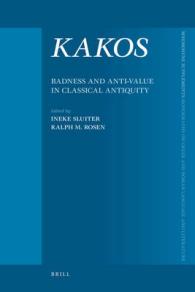- ホーム
- > 洋書
- > 英文書
- > History / World
基本説明
New in paperback. Hardcover was published in 1999. Examines Mongolia's history over the past century, with special attention to the competing influences of Russia, China, and Japan.
Full Description
The remote vastness of Mongolia has remained somewhat of a mystery to most Westerners - no less so in the 20th century. Homeland of the legendary conqueror Chingiz Khan, in modern times Mongolia itself has been the object of imperial rivalry. For most of the 20th century it was under Soviet domination. Mikhail Gorbachev began the withdrawal of Soviet troops from Mongolia in 1989, a process completed in 1992. By 1996 a coalition of opposition parties triumphed in national elections, and Mongolia launched itself on a new course. It is perhaps the most intriguing of the post-community "transition" societies. This volume examines Mongol history over the past century, embracing not only Mongolia proper but also Mongol communities in Russia and China. Contributions, based on new archival research and the latest fieldwork, are from the world's top experts in the field - including four authors from Mongolia and others from Japan, Russia, Taiwan, Great Britain and the United States. Stephen Kotkin's introductory chapter is an overview of Mongol studies. The essays in part 1 examine Sino-Russian competition over Outer Mongolia. Part 2 looks at international diplomacy in Mongolia, including the role of Japan. Part 3 focuses on contemporary issues ranging from economic and cultural change to emergent elites. A concluding essay surveys Mongolian foreign policy.
Contents
Introduction; I: Sino-Russian Competition over Outer Mongolia; China's "New Administration" in Mongolia; Russian Merchants in Mongolia: The 1910 Moscow Trade Expedition; Russian Diplomats and Mongol Independence, 1911-1915; The Buriat Alphabet of Agvan Dorzhiev; II: International Diplomacy Concerning Outer Mongolia; Aspects of Soviet-Mongolian Relations, 1929-1939; The Final Consolidation of the USSR's Sphere of Interest in Outer Mongolia; Sino-Soviet Diplomacy and the Second Partition of Mongolia, 1945-1946; Mongolia and Japan in 1945-1995: A Half Century Reconsidered; III: Mongolia Today; A Survey of the Mongols in Present-Day China: Perspectives on Demography and Culture Change; Mobility, Technology, and Decollectivization of Pastoralism in Mongolia; The Eight-hundredth Anniversary of Chinggis Khan: The Revival and Suppression of Mongolian National Consciousness; Nationalism, Elites, and Mongolia's Rapid Transformation; Epilogue






